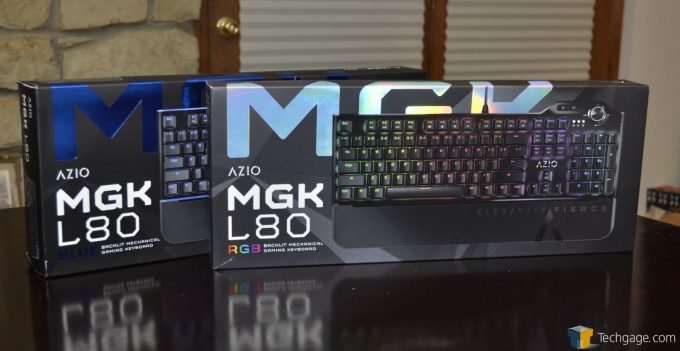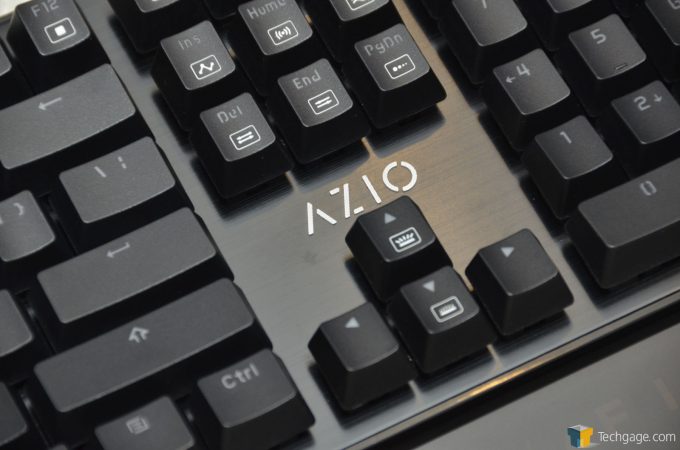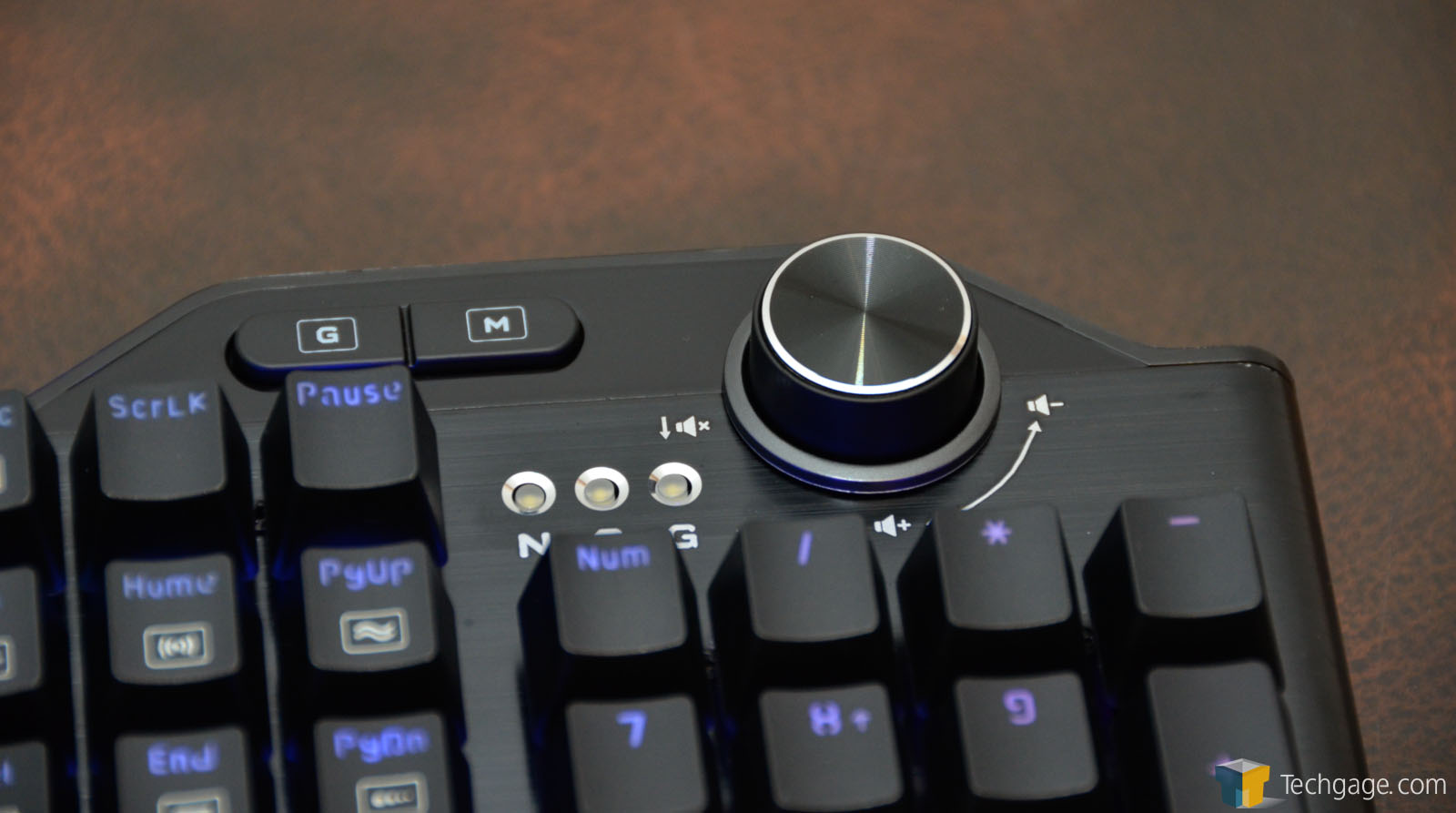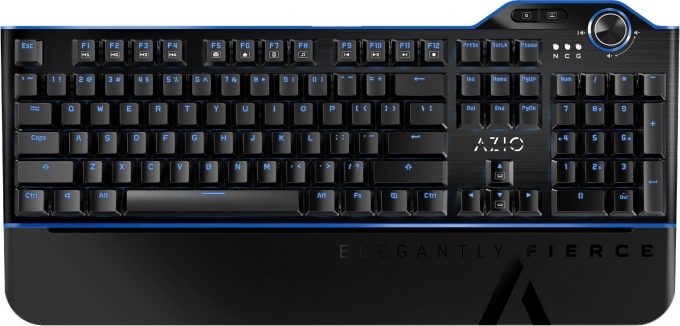- Qualcomm Launches Snapdragon 4 Gen 2 Mobile Platform
- AMD Launches Ryzen PRO 7000 Series Mobile & Desktop Platform
- Intel Launches Sleek Single-Slot Arc Pro A60 Workstation Graphics Card
- NVIDIA Announces Latest Ada Lovelace Additions: GeForce RTX 4060 Ti & RTX 4060
- Maxon Redshift With AMD Radeon GPU Rendering Support Now Available
AZIO MGK L80 RGB Mechanical Gaming Keyboard Review
Mechanical keyboards are all the rage right now, but finding a good one on a budget can be tough. AZIO made a good first impression in the past, and seeks to do it again with the Kaihl Brown equipped MGK L80. Coming in a couple flavours, we take a look at the RGB edition and see how it fares.
Last August we took a look at the Patriot V760 mechanical keyboard. It was my first real experience with a mechanical and I walked away from the review with a positive impression.
Part of that favorable impression at the time could be attributed to it being my first mech board. That said, I switched to the V760 as my primary board at home and in the months between that review and now, I am still using the V760 and am just as happy with it now as I was then.
Not too long ago, Jamie took a look at the AZIO MGK1 and while it was our first look at an AZIO product, he had nothing but praise for the mechanical board. Today we continue our exploration of the AZIO portfolio with a look at its newest addition to the lineup, the MGK L80.
The L80 comes in three flavors, red, blue and RGB, each is a bit different from the others. We were sent all three but this review covers the brown switch equipped RGB model. This allows me to make a side by side comparison to another keyboard with the same type of switches.
All three boards have the same layout. The same macro buttons and volume knob. The only differences are the LED colors and the switches used. The L80 Blue has blue Kailh switches and the red and RGB both have brown Kailh switches. Switches aside, the boards have backlighting that aligns with their respective names.
Because the MGK1 that Jamie worked with had blue switches, we will focus on the boards with browns. Because the only difference between the red and RGB boards is their LED lighting, we will be worked exclusively with the RGB board as stated before.
The feel of the L80 is almost identical to the Patriot V760 that we looked at earlier this year. The brown Kailhs, like Cherry browns, are far more quiet than their blue cousin and generally only make a noise when the key bottoms out on the board.
Because of their quieter design, they lack the clicking sound that the blue switches make. Perfect for use in an office environment and one that I have found to be a perfect compromise for those looking for a great typing and gaming keyboard without the loud clicking sound made by the blues. Even the Cherry red switches are a bit louder than the browns.
The Hardware
The L80’s layout is as normal as keyboards get. A full-sized keyboard with a number pad situated on the right, the L80 does nothing that departs from the keyboards we’ve grown accustomed to over the course of our digital lives. Where the L80 differs from many other keyboards on the market however, is the addition of a volume control nob in the upper right hand of the board.
This is a feature I’ve missed and am happy to see included. Beyond that, the only other buttons on the L80 are a pair of buttons labeled G and M. The G switches the board into gaming mode. What this does is set the F1 through F4 keys to macro functionality. That’s all well and good, but how do we program those macro keys? That is done with the M key.
Like with the MGK1 that Jamie reviewed late last year, the L80 lacks any software needing to be installed on the host PC or Mac. The L80 is truly plug and play. This will be seen by many as a negative, given the L80 is being marketed as a gaming keyboard. For others, this is a positive.
Without any software to be installed, the overhead on the computer’s OS, however small that might be, is eliminated and the board is ready to go immediately after plugging it in. For those that want to use macros on the L80, the process to set them up isn’t too terribly complicated. The process is as follows:
Make sure the keyboard is in Gaming Mode by pressing the “G” button. The “G” LED should be lit.
- Press the “M” button to enter Record mode. The 3 LED status indicators will start to flash, indicating the keyboard is in Record Mode.
- Press the key you would like to record (F1 to F4).
- Enter the Macro sequence you wish to program.
- Press “M” button again once you are finished. The 3 LED status indicators will stop flashing indicating recording is complete.
Another welcome feature of the AZIO L80 is the magnetic palm rest. It attached firmly to the front of the keyboard and is designed with a pleasant angle. Because it’s magnetic, it can be easily removed if you already have a palm rest that you prefer, but in the couple of months that this board has been tested, we’ve been pleased with the rest that ships with the board.
Custom Backlight
Like the MGK1 before it, the L80 has a set of pre-programmed backlighting profiles. There are six in total; spectrum, splash, wave, marquee, custom, and reactive. We will drill down into a little more detail.
- Spectrum – All keys uniformly and subtly cycle through the full spectrum of colors.
- FN + INS
- To pause the motion of color flow, press FN+DEL
- FN + UP Arrow: Increase Brightness (25 Levels)
- FN + DN Arrow: Decrease Brightness (25 Levels)
- FN + L Arrow: Change Color flow direction Left
- FN + R Arrow: Change Color flow direction Right
- Splash – The keys reveal a variety of colors through a ripple effect.
- FN + HOME
- Pressing FN+HOME again will change splash mode
- FN + UP Arrow: Increase Brightness (25 Levels)
- FN + DN Arrow: Decrease Brightness (25 Levels) ]
- FN + + : Increase Speed of Color
- FN + – : Decrease Speed of Color
- Wave – The RGB backlighting moves across the keyboard in a subtle and gradient format.
- FN + PGUP To pause the motion of color flow, press FN+PGUP
- FN + UP Arrow: Increase Brightness (25 Levels)
- FN + DN Arrow: Decrease Brightness (25 Levels)
- FN + L Arrow: Change Color flow direction Left
- FN + R Arrow: Change Color flow direction Right
- Marquee – The backlighting shifts across the keyboard in a spectrum of colors.
- FN + DEL
- To pause the motion of color flow, press FN+DEL
- FN + UP Arrow: Increase Brightness (25 Levels)
- FN + DN Arrow: Decrease Brightness (25 Levels)
- FN + L Arrow: Change Color flow direction Left
- FN + R Arrow: Change Color flow direction Right
- Custom – You have the ability to effortlessly set the desired backlight color to each key.
- FN + END
- To customize this mode, press FN+END twice
- Push any key repeatedly and you will cycle through the 7 preset color options available
- After you have finished customizing the key’s colors, push
- FN+END again to exit Edit Mode
- Reactive – Each key lights when pressed and stays lit momentarily before fading back off.
- FN + PGDN
- To toggle 7 preset colors, press FN+PGDN repeatedly
- FN + UP Arrow: Increase Brightness (25 Levels)
- FN + DN Arrow: Decrease Brightness (25 Levels)
All that seems like a lot but once you’ve done it a few times, it will become second nature. That said, one of the greatest benefits of accompanying software is the ability to save custom settings for lighting. You forfeit that with the L80.
Final Thoughts
As Jamie said in his review of the AZIO MGK1, the market is “rather crowded” at this time. It seems every other month a new company brings to market a mechanical keyboard. Some have found creative ways to keep the pricing down. AZIO does this by using Kailh switches in their boards. In my experience, this is not a bad thing. The browns provide decent feedback and keep the noise down to a minimum (where mechanicals are concerned).
In the few months I’ve used the L80, it’s been a solid keyboard, void of issues of any kind. I’ve used it daily at the office and almost every single person to walk by, comments on the colors that it puts off. I keep my board in the marquee setting, which certainly catches the eye when passing by. If anything, it’s a great conversation starter. This feature is not exclusive to the L80 but something that is unique is the pricing.
At the time of publishing, the L80 Blue and Red can be found online for $70 USD and the RGB model for a measly $10 more. There are many mechanical keyboards on the market and almost as many with RGB lighting. Few however are priced as low as the AZIO L80. One thing to stress is that while the pricing is right, the build quality does not reflect that. The L80 is a very solid keyboard and would be a good buy at $100.
Given that pricing is currently well below that mark, the AZIO L80 is an incredible value and something that anyone on the lookout for a mechanical keyboard should take a long look at. The board has all of the features I loved in the Patriot V760 and even addressed the one downside I had with it by adding a volume dial and media keys.
Support our efforts! With ad revenue at an all-time low for written websites, we're relying more than ever on reader support to help us continue putting so much effort into this type of content. You can support us by becoming a Patron, or by using our Amazon shopping affiliate links listed through our articles. Thanks for your support!















